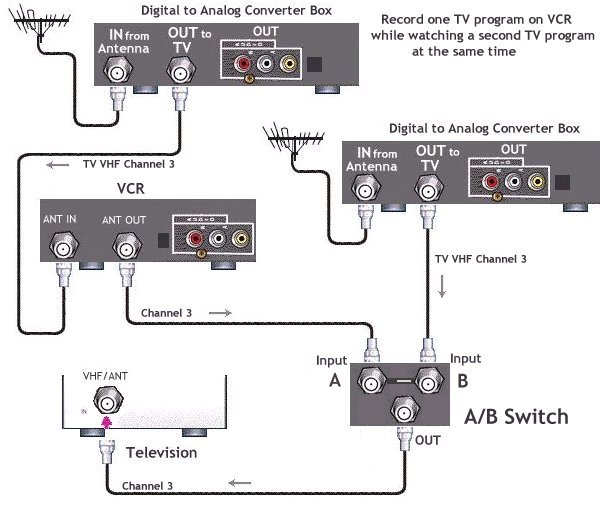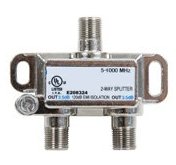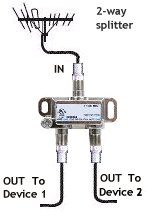Watch one TV program, record another at same time
DIGITAL TELEVISION
Do you have a television set in your home that works with the help of rabbit ears or a rooftop antenna?
Television broadcasting is moving from an old standard known as analog to a new standard, called digital. After February 17, 2009, all television broadcasts will be digital. After February 17, 2009, all analog televisions getting programming ?over the air through an antenna will need to be plugged into a special television converter to receive digital TV broadcasts.
WHO NEEDS A CONVERTER?
A digital-to-analog converter is a device that plugs into your television set. Plugging a converter into your existing television will allow you to continue to get your programs after February 17, 2009. The converter option is not for everyone. Most people have television sets connected to cable, satellite, or other pay television service. Converters will NOT be needed for these TV sets. If you have a television with a digital tuner, then you will not need a converter. If you haven?t purchased a television in the last five years, it probably does not include a digital tuner. An older set not connected to cable or satellite service is a good candidate for a converter.
How it works
The TV converter box allows you to watch your TV programs on your old analog TV but what if you want to watch a TV program and another TV program comes on at the same time. In the old days you used a VCR to record one program while you watched the other program. Your old VCR can still be used to record TV shows. Your VCR however has to also get a converted signal, digital to analog, so it can record, because the VCR can only record in analog, not digital. Your old VCR has an analog TV tuner just like your older analog TV set. But you only have a digital TV signal coming from your antenna. What you need is a second TV converter box to tune and convert TV signals for your VCR.
The antenna picks up broadcast digital TV signals and passes them to the TV converter box. The converter box provides an analog signal out for the TV (channel 3 or 4) and connects to the A/B switch, which, when in the "B" position, passes the signal thru to the TV. Set the TV on channel 3 (or 4). When in the "A" position, the switch passes the analog TV signal to the TV from the VCR. When watching TV, you will tune the channels on the converter box and select channel 3 (or 4) on the TV set. To record on the VCR, set the VCR to channel 3 (or 4) and tune the channel you want to record on the converter box. When you want to play back the TV show from the VCR, switch the A/B switch to the "A" input. The TV remains on channel 3 (or 4).
Components:
o VHF/UHF TV Antenna (2). Small indoor or large outdoor antennas.
o Signal splitter. You can use a splitter if you only have one antenna.
o A/B switch.
o Digital to analog TV converter box (2).
o Four RF coaxial cables (RG-59 or RG-6).

Hookup for analog TV without A/V inputs, only a single RF jack.
A/B Switch

An A/B switch is a selector device that allows you to choose which signal source your TV uses at any given time. You may also find an A/B switch useful for connecting a home video-game system, or for advanced TV viewing options, such as watching one channel while recording another.
A/B switches are available in a small manual type (about $3.95) where you slide the switch to one side or the other, or a remote control type where you do not have to get up from your easy chair to flip over to the other side. Radio Shack sells a remote control type for $39.99.
Radio Shack A/B switch
Google search for A/B switch
RF Splitter

Google search for RF splitter
A signal splitter will allow you to provide TV signals to multiple devices using only one source. When the source signal is split however, it is sometimes diminished in strength. RF Splitters are rated in two ways: The frequency range they are designed to handle, and the insertion loss incurred when a signal passes from the input to any of the outputs. A frequency range of 55 Mhz to 900 Mhz covers the VHF, UHF, FM, and CATV bands. The insertion loss is measured in dB. The lower the number, the better. The loss in a good splitter is around 4.0 dB per split. An average splitter has around 4.5 dB loss per split.
If you only have one signal source (only one antenna) you can use an RF splitter to route the same signal to two different devices such as converter boxes.

Home Depot, Wal-Mart, Radio Shack all sell these splitters for home use. Cost is around $3 to $5.
RF splitter
RF splitter RAM electronics
• How to setup converter box for the first time
• Audio Video Cable Types
• Cable Connections - hookup
• How to connect DVD player
• See over 50 hookup diagrams
• How do I know a TV is a HDTV
• Things you should know about HDTV
• Setup HDTV
• Buying Guide for HDTV
• Converter box hookup
• What kind of TV do I have
Got a question? Audio Video Forum
Columbia ISA - Empowering consumers thru information.
columbiaisa@yahoo.com (comments, questions)